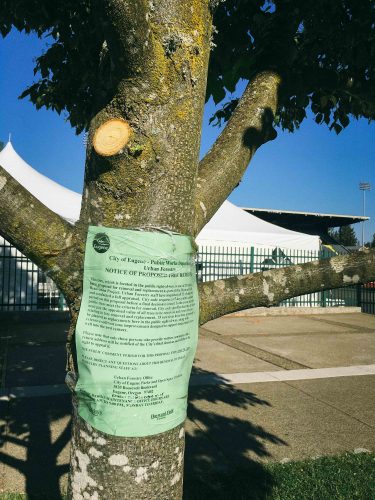
As the area around Hayward Field bustles with preparations for the weekend’s Prefontaine Classic track meet, the leafy trees along Agate Street sport new tags.
Trees from 15th to 18th avenues are taped with green fliers explaining that the trees will be cut down as part of the Hayward Field Renovation Project.
Maryanne Francis, who lives not far from the track, says the removal will “destroy the ambiance of the neighborhood” — and that’s not even “the horrible edifice they are going to build there.”
The “horrible edifice” of which she speaks is the planned Phil Knight-funded massive new Hayward Field, which calls for the teardown of the historic East Grandstand where coach Bill Bowerman once watched Steve Prefontaine run past.
Those calling for the grandstand’s removal have tried to call attention to its supposed disrepair. That’s not stopping the University of Oregon, though, from packing it with track fans for the May 25-26 meet.
Francis says of the tree removal, and rush to build a new Hayward, that it’s “not the right thing do and especially in the way they are doing it.”
She also objects to the short period of time the public is given to comment before the trees are removed — only 15 days, and over a holiday weekend.
Scott Altenhoff, an urban forester with the city of Eugene, expands on some of the details mentioned on the green fliers.
He says the city doesn’t have the legal authority under city code to deny the permit if all the criteria are met. But he says when it comes to how the trees are replaced the city does have the legal authority to add conditions to the tree removal permit.
Altenhoff says the conditions will ensure there is not a monoculture but instead a diversity of trees.
He says that the trees that are removed will not only be replaced with 33 new trees, but the soil itself will be enhanced. There will be root zone and soil improvements to help the trees live a long time because, he says, poor soil is one of the greatest challenges for urban forestry.
Altenhoff says his default position as a forester is to preserve personal connections — he’s run the Eugene marathon past that alley of trees and memories are preserved by them. But, he says, “if I can’t change the trajectory, I’d like to focus on the future.”
Also, Altenhoff says, even when construction companies follow the law, trees close to the development can be damaged by construction impacts and wind up having to be removed later anyway and the public covers the cost instead of the developer.
“I do know trees are an essential part of what Eugene is all about and what the world needs,” he says. “While historically development and caring for the environment were opposed, I want to start a having a conversation.”
Those wishing to comment on the tree removal have until May 30. Send written comments to pos@ci.eugene.or.us or to the Urban Forestry Office, Eugene Parks and Open Space, 1820 Roosevelt Boulevard, Eugene, OR 97402.
Those concerned that the East Grandstand be preserved as Hayward is renovated can attend a public meeting organized by the East Grandstand Supporters 7 pm Thursday, May 31, at Agate Hall on the UO campus.